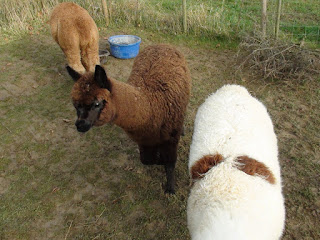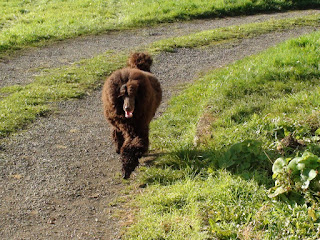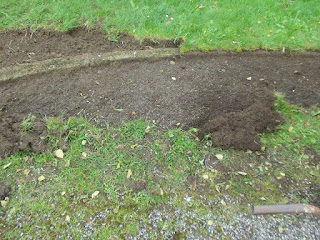Happy Birthday to lovely Adhara and the 'Stars' litter, who are 4 today!
Also, Happy 2018!
Breeder of black and brown Standard Poodles, rare breed farm animals, and alpacas near Bath.
Sunday, 31 December 2017
Monday, 25 December 2017
Saturday, 23 December 2017
Terminology
Recently, a friend asked me for help in understanding a pedigree of an animal. The person offering the animal for sale had tried to explain the pedigree by describing the ancestors in words, because the place the advert was posted apparently didn't have any facility to enter a pedigree. Unfortunately as I studied the description, it became apparent that the pedigree was totally unintelligible because the person who had written the advert did not understand the proper terminology. The best I could suggest was that the friend contact the advertiser and ask for a scanned copy of the pedigree. Hence I am writing this blog post to explain how to use proper terminology to discuss a pedigree when the pedigree on paper or computer isn't available.
| |||||||||||||||
Here's an example pedigree that I am going to use as an illustration. Fluffy has a sire, a dam, four grandparents, and (assuming there isn't linebreeding behind Fluffy) eight great-grandparents. Pedigrees are the cornerstone of breeding animals. As well as containing a wealth of information, they allows you to calculate information such as COI and, if they go back far enough and you have the software, influences of particular individuals. In order to get the most out of a pedigree, you need to understand how to read it and know the proper terms.
To the right of any animal in the pedigree appear the names of the sire (father) and dam (mother). These are terms that specifically mean father or mother in the context of relations between animals. They are only correct when used where you would use mother or father.
It is not correct, for example, to use 'sire' to refer generally to a male animal. The correct term in this case is the specific name for the male within the species, e.g. macho, dog, stallion. A 'stud' is a male animal known to produce functioning sperm, who mates with females and causes them to become pregnant. A male animal who has not yet done all of these things should not be referred to as a stud. We can also talk of animals as being 'sired by' or simply just 'by' the male who is their sire. So Fluffy is 'sired by' or 'by' Sire in the pedigree. In the pedigree, the name of the sire is always shown above the name of the dam, which makes it easy to understand if the animal's sex is not obvious from its name. If we think about it, this is pretty intuitive as well, since in domestic mammals, the act of conception begins with the male mounting the female. This is also the origin of a term you might hear when discussing animal breeding -- if someone says they are going to put Studdy McStudface 'over' Nice Girly Girl, it just means they are going to put them together in the hope they will mate and have young.
I put Costa over Olivia (I just put them in a field together; the rest they did themselves)
Equally, a 'dam' is an animal's mother, and not a term to indicate a female generally. She has a name specific to females of her species that can be used for this purpose, such as bitch, mare, hembra, etc. A female who has not yet mated with a male is often referred to as a 'maiden'. It's less common, but not incorrect, to refer to a male who has not yet mated also by this term. A female who has had a mating that did not result in a pregnancy would no longer be considered a maiden despite not having borne young, and confusingly with the advent of techniques like artificial insemination, it's sometimes possible for maiden animals to have given birth! In many animals, maidens can be difficult to mate, which is why people often wish to use an experienced stud rather than a 'green' male on them, who will be patient enough not to terrorise them but persistent enough to get the job done. Females who have mated before and know what is involved usually mate quite happily.
The dam appears to the bottom right of her progeny (progeny or get are names used to describe the offspring of animals) as discussed above. We do not use 'by' as we would with a sire to talk about a dam's progeny; progeny are not 'dammed by'. Instead, the young are said to be out of the dam. Again this is reasonably intuitive, as the cria/puppies/foal/ferrets come out of the mother and never the father. So Fluffy is out of Dam and by Sire. We can also say that Fluffy is one of Dam or Sire's progeny, or that we put Sire over Dam and Fluffy was born as a result.
Going deeper into the pedigree, the parents of the parents are called granddams and grandsires, just as we call our parents' parents grandads and grandmas. We use the terms 'maternal' and 'paternal' to differentiate the grandparents that appear on the sire's and the dam's side of the pedigree, so if someone talks about the paternal granddam, we know immediately who in the pedigree this animal is and how she is related to the animal we are discussing. At the great-grandparent level, it becomes rather more difficult, but the animals at the far top and far bottom of the pedigree have a special significance. If you trace the father's father's father's father and keep going in this way, you are following what's called the patriline. The patriline is genetically significant because the y-chromosome is passed from father to son and in no other way. The mother's mother's mother's mother is called the matriline, and this is also genetically significant because mitochondria (a small but important part of the genome of an animal) are passed from a mother to her offspring but cannot be passed on by males. If you follow the matriline and patriline to where records end, you will find a single male or female individual, and the animal is said to be of this (maternal or paternal) tail line. Generally each breed has a limited number of tail lines, and if your animal happens to have an unusual one, it might influence what sex of its offspring you keep.
I hope this blog post helps people who are struggling to discuss pedigrees clearly! Below is a handy glossary of terms.
By: (or sired by) describes the relationship of an individual with its father
Dam: the mother
Get: the offspring (young) of an animal
Grandsire/granddam: grandparent of that sex
Maiden: an animal that has not yet mated
Maternal: of the dam's side of the pedigree
Maternal tail: the female at the very bottom of the pedigree as far back as it goes where the matriline terminates
Matriline: the mother's mother's mother's mother...
Open: if a female animal is described as being open, it means she is not pregnant. In animals who have long gestations such as alpacas, females are mated soon after giving birth, so they ideally are pregnant most of the time, but a breeder may choose to leave a female 'open' for various reasons, such as if she has lost condition and needs to recover before being rebred.
Open: if a female animal is described as being open, it means she is not pregnant. In animals who have long gestations such as alpacas, females are mated soon after giving birth, so they ideally are pregnant most of the time, but a breeder may choose to leave a female 'open' for various reasons, such as if she has lost condition and needs to recover before being rebred.
Out of: describes the relationship of an individual with its mother
Over: used to describe a mating, with the male always being 'put over' the female. Similarly you might also hear that he has covered or that he has served the female, or that she has been covered or served by him.
Paternal: of the sire's half of the pedigree
Paternal tail: the male at the very top of the pedigree as far back as it goes where the patriline terminates
Patriline: the father's father's father's father...
Pedigree: an ordered table of the ancestors of a particular individual
Progeny: the offspring (young) of an animal
Sire: the father; also a verb meaning of a male to produce offspring
Stud: a male animal who is proven fertile and who mates with females and causes them to become pregnant
Thursday, 21 December 2017
Happy Solstice
Happy Solstice. I just ate my Toulouse goose. I feel slightly bad about this, as this was not a young bird I'd reared to eat, but something I'd originally intended to be part of a breeding programme. There unfortunately doesn't seem to be any interest in the breed in this country, and I never found a male of the same breed, so she lived in with the other geese, which are all West of England, but this caused more problems than it solved as it was never possible to tell who had laid what egg, and breed conservationists don't want eggs that hatch into mutt geese. I've decided I need to concentrate on the West of Englands only. It will be strange seeing the other geese in the paddock without her there, although at least I know she lived a good life and died without pain (in particular considering the main use of this breed in its native country is for foie gras).
Fortunately it was not bad at all, if a bit tough, considering the goose was about four years old. Digest in peace.
Fortunately it was not bad at all, if a bit tough, considering the goose was about four years old. Digest in peace.
Wednesday, 13 December 2017
In the Bleak Midwinter
Adhara enjoyed having a warm shower and being dried -- but not so much the cold wet interim. As the nights get longer, the days darker, the weather worse, and the ground progressively more sodden, it becomes harder and harder to take pictures of anything.
The cats are rarely seen, but they came up to the house yesterday to make it known their water had frozen and they wanted a drink.
Work is full on at the moment as a lot of orders for collars and things have come in, and turkeys, geese, and other birds who are expected not to continue to live here into the new year have their number up.
Sunday, 26 November 2017
Cria Weaning and Saffi being Naughty
Patience and Fleur have been separated from their mothers for weaning. They're both well-grown and ready for it, but poor Fleur in particular misses Poppy. Saffi did a stupid thing in this video, but it was quite impressive.
Wednesday, 22 November 2017
Sunday, 22 October 2017
Tuesday, 17 October 2017
Powered by Paca Poo
Today the heucheras and the Amelanchier moved home, along with a few other bits and pieces.
The drive in autumn
Serious garden work and planting always entails trips back and forth from the alpaca paddocks to acquire paca poo to add to the soil. Hence this is an alpaca blog post, for the sake of avoiding having two gardening posts in a row for the people who come here to read about animals.
Most of this grazing is still very long, and although they have grazed the edges and a strange spot in the centre, they hadn't poo'd there, and I wandered round and round with a wheelbarrow but could not find any! Rather than following them about for an hour or so until one of them needed the toilet, I went to the other paddock where the boys are.
Trident and Costa spend their time engaged in serious manly pursuits, such as horseplay, neck-wrestling, and humping each other. They don't live with the females. The lack of female company seems to have resulted in a loss of standards inherent to the disgusting bachelor lifestyle, because as it turns out, they don't appear to have be using certain areas for toilets at all, and there was poo all over the paddock like they'd just done it wherever they happened to be standing. Some time later, there was enough paca poo to go on the garden.
I can't move any more plants today, as I need to wait for my fertiliser supply to regenerate.
Sunday, 15 October 2017
Ecce domus, quod est stercore foraminis
For reasons that were not anticipated, the entire garden on the west side of the house is having to be dug up to make way for groundworks, and all the shrubs are having to be transplanted to other places around the site. Autumn and winter are the best times to do this, so the work to relocate the garden commenced this weekend.
This part of the garden has not been maintained for a long time and the stone marking the edge of the path has become buried and overgrown, so in a way it is a good excuse to sort it out and make it nice again.
Nandina domestica
This part of the garden has not been maintained for a long time and the stone marking the edge of the path has become buried and overgrown, so in a way it is a good excuse to sort it out and make it nice again.
Acers and Tamarix tetranda
Subscribe to:
Comments (Atom)




















































